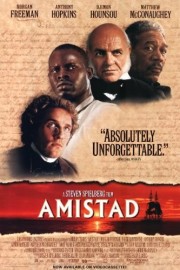Amistad
In “Amistad,” Steven Spielberg sets aside the subtle brushstrokes he used in his 1993 masterpiece, “Schindler’s List,” and tells the story of the rebellion aboard a slave trader boat in 1839 with bold visuals and his typical penchant for sentimentality. That doesn’t diminish its power, but rather, is an example of how Spielberg realizes that every story must be told in the way that best suits it. The harsh, unforgiving realism of “Schindler’s List” would be wrong for this film, although Spielberg finds different ways to incorporate it into the film he’s made.
Though the film is populated by actors such as Morgan Freeman, Matthew McConaughey, Nigel Hawthorne, Chiwetel Ejiofor, Pete Postlethwaite, Anna Paquin, and Anthony Hopkins (among many more), the film’s most striking, and unforgettable, performance is given by Djimon Hounsou as Cinque, the slave who leads the uprising on the ship, Amistad. A model at the time, Hounsou’s striking physical presence is the first thing we see, fittingly since the first thing we see is Cinque pull a nail out of a ship’s board, which he uses to free himself from his chains, and lead the rebellion. But though much of his dialogue, especially at the start, is in a different language (without subtitles, even), we understand completely Cinque’s thoughts, and feelings, especially when he remembers his family and life back in Africa, along with his initial interactions with McConaughey’s lawyer, who is acting on behalf of the slaves. It’s unfortunate that his career since, save for a shining, Oscar-nominated performances in “Blood Diamond” and “In America,” has been primarily as “the muscle” in films like “The Island,” “Lara Croft Tomb Raider: The Cradle of Life,” “Constantine,” and “Gladiator,” although the latter one was a terrific role for the actor. This should have been one of those Oscar-nominated roles; that it wasn’t is the Academy’s shame, not Hounsou’s. It takes real talent to outshine the likes of Hopkins and Freeman, and Hounsou is the film’s heart and soul.
The film is primarily a courtroom drama, as written by David Franzoni’s screenplay, but its narrative is deeply personal, in addition to the moral questions it asks with regards to slavery in the 19th century. While the legal battle over whether the slaves aboard the Amistad were born slaves, or whether they were taken illegally from Africa (as the transportation of slaves on the seas was outlawed at this time), is a fascinating one, Spielberg’s real interest is how these noble men, from different worlds, connect with each other, and help enrich the other’s lives. It isn’t an easy journey, however, especially when Cinque has to recount the torture he witnesses, and endures, along the Middle Passage. This is one of Spielberg’s most harrowing sequences, shot with unflinching feeling that puts us inside the terrible reality of the scene. It’s heartbreaking to watch, and its impact far outweighs the sentimentality Spielberg displays throughout the rest of the film.
This was the first time in nearly 15 years since I’d last seen “Amistad,” and I’ll admit, I wasn’t sure if it was going to hold up all that well. As it turns out, it held up really damn well. This is a smart, emotional film, superbly crafted by Spielberg and his crew of great collaborators, from cinematographer Janusz Kaminski to editor Michael Kahn to composer John Williams, and performed by a fine cast with all the soul and compassion they can muster. Yes, it plays towards its uplifting conclusion with obvious intentions, but a memorable film doesn’t have to be original; it just has to be a story worth telling, and “Amistad,” which was shepherded by choreographer Debbie Allen for years before Spielberg took it on, is certainly that.










